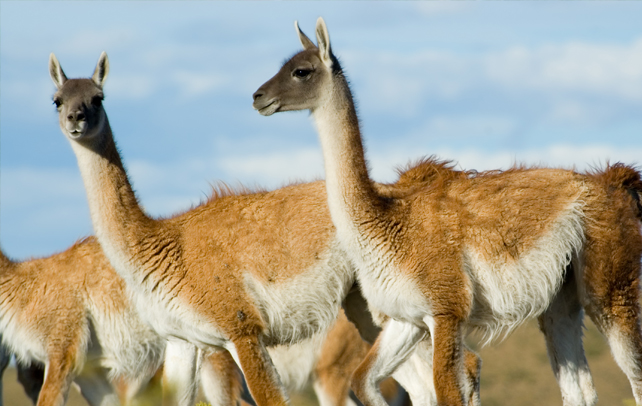Fun Facts About Guanaco

One of the largest wild mammals found in South America, Guanaco, is like a younger twin of a camel. Just shrink its size, remove the lump and place it in South America, you will get a guanaco in result. It is a willowy animal with pallid brown back, big pointed ears, white base, short tail, longer neck and a significantly large head. Customarily, they are found in Bolivia, Ecuador, Peru, Chile and Paraguay and historically been hunted for their meat, their numbers came down to near alarming levels. They are hunted even today, mostly for their fur However, owing to protective laws imposed by the authorities their numbers have increased significantly and presently, there are around 600,000 guanacos. Check out some interesting and amazing information on guanacos in the following section.
Fast Facts
Binomial Name: Lama Guanicoe
Kingdom: Animalia
Phylum: Chordata
Class: Mammalia
Order: Artiodactyla
Family: Camelidae
Genus: Lama
Species: L. Guanicoe
Subspecies: Lama guanicoe guanicoe & Lama guanicoe cacsilensis
Adult Length: 5.77 feet to 6.63 feet (Average, 6.23)
Shoulder Height: 35 to 47 inches
Weight: 80 to 120 kg
Life Span: 20 to 25 years
Diet: Herbivorous; grasses, shrubs, lichens, and fungi
Predators: Pumas and mountain wolves
Range: South America,Bolivia,Peru,Ecuador,Chile,Argentina, Patagonia andParaguay
Habitat: Open grasslands, lower plateaus, plains, coastlines to altitude of 13,000 feet
Age of Sexual Maturity: Males at 730 days/ Females at 365 days
Gestation Period: 300 to 330 days
Average Litter Size: One
Interesting & Fun Facts About Guanaco.
- A guanaco has llamas and alpacas as its domestic descendants and is closely related to camels and vicunas, all of which are the members of the camel family.
- Since the grass quality in guanacos habitat tends to be poor, nature has provided them with three-chambered stomach so that they can extract sufficient nutrition from their food.
- Guanaco has a specially acclimatized heart and blood cells which help it fight with the atmosphere at high altitude where air does not have sufficient amount of oxygen.
- Surprisingly, a teaspoon blood of a guanaco contains nearly 68 million red blood cells, which is four times the number of red blood cells present in human blood.
- Guanacos have eyes on the sides of their heads that allow them to look all around for threats. Their ears are straight and erect, giving them an attentive and curious look.
- The digestive system of a guanaco is very competent in comparison to that of a sheep. That is why a guanaco reflects more efficiency in digesting dry matter and crude fibre.
- The pelt of guanacos consists of two layers viz. outer and inner layer. The outer layer works as a guard hair whereas the inner layer is soft in texture.
- As their habitats do not provide for any hiding place to hide themselves at the time of attack from their predators, running is the only option available to them to escape. They have sufficiently high running speed at 56 kilometres per hour.
- Like camels, guanacos, can live without water for several days. They compensate for their body’s water requirements by gaining moisture from plants they eat.
- Guanacos get their food by grazing (feeding on grass) as well as by browsing (leaves and buds of shrubs). Other than grazing and browsing, a guanaco also eats epiphytes, lichens and fungi.
- The overgrazing by sheep during winter season often creates food shortage for guanacos, which is a prime reason for guanacos deaths in wild in the winters.
- Guanacos prefer to live in groups which are usually family groups and bachelor groups.
- The family groups have one leading male guanaco with usually 10 female guanacos and babies, whereas adult males are found to have their bachelor group with as high as 50 members.
- Male guanacos tend to bite each other’s front legs and bend their neck together during fights, for dominance of the herd, with each other. The winner of such fights becomes the leader and loser is supposed to leave the group.
- A guanaco spits when it gets angry or hurt.
- When danger in the form of a mountain lion of other powerful animal is anticipated, guanacos make loud warning call, leading to their swift escape across the rough landscape. Usually, the leader of the group runs after the rest of the group has escaped.
- The soft, downy fibre coat of a guanaco is of very high value due to its soft texture and rarity. The only other fur-bearing animal, having fur better than guanaco, is its wild cousin, the vicuna.
- During the mating season, the number of members in the family group increases. Most of the guanaco births take place between mid-December and January, though reproduction continues from November to March.
- With a gestation period of around 11 months, a female guanaco bears a single baby, once every year. The baby guanaco is called a chulengo. Amazingly, even an half-an-hour old guanaco can gear up and follow its mother.
- As male guanacos reach the age of one, they are forcibly made to leave the family group by adult dominant male, and form their own group of adult males.
- Several native groups of Andes and southern region of South America used to consider guanacos as a chief source of protein.
- These are one of the most adaptable animals with reference to climatic conditions and shelter requirements.
- Because of its thriving population, the IUCN red list has categorized the species of guanacos as ‘Least Concerned’.









